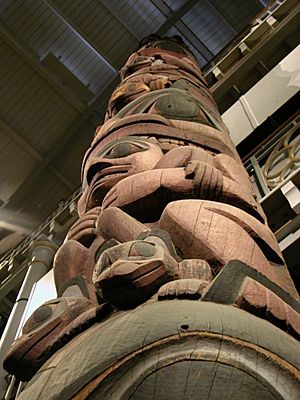Pitt Rivers Museum facts for kids

Pitt Rivers Museum interior, 2015
|
|
| Lua error in Module:Location_map at line 420: attempt to index field 'wikibase' (a nil value). | |
| Established | 1884 |
|---|---|
| Location | Parks Road, Oxford, England |
| Type | University museum of archaeology and anthropology |
| Visitors | 468,013 (2019) |
The Pitt Rivers Museum is a fascinating place in Oxford, England. It's part of the University of Oxford. This museum shows off amazing collections of archaeology and anthropology.
Archaeology is the study of human history through digging up old things. Anthropology is the study of human societies and cultures. The museum is right next to the Oxford University Museum of Natural History. You can only get into the Pitt Rivers Museum by walking through the Natural History Museum first!
The museum started in 1884. A man named Augustus Pitt Rivers gave his huge private collection to the university. He had two main rules for his gift. First, the university had to hire a permanent teacher for anthropology. Second, they needed a special building just for his collection.
Edward Burnett Tylor became the first anthropology teacher in the UK in 1885. The museum's staff still help teach students today. The first person to look after the museum's items was Henry Balfour. The original gift had about 22,000 items. Now, the museum has over 600,000 objects! Most of these items were given by explorers, scholars, and missionaries over many years.
Contents
Exploring the Museum's Collections
The main part of the museum is a huge, rectangular room. It has tall columns and two upper levels, like balconies. The ceiling is very high and arched. This big room is packed with glass display cases and exhibits. It feels like stepping into a treasure chest!
How Objects Are Organized
The museum's collection is arranged in a special way. Objects are grouped by how they were used, not by when they were made or where they came from. For example, you might see many different kinds of spears from all over the world, all displayed together. This shows how people in different places made similar tools.
This unique way of organizing things was Pitt Rivers' idea. He wanted to show how human tools and cultures developed over time. Even though ideas about culture have changed, the museum still keeps this original layout. This is because of the rules Pitt Rivers set when he gave his collection.
Because the museum has so many objects, the displays change sometimes. This means there's always something new to see!
Changes to Displays
In 2020, the museum made some important changes. They decided to remove certain displays, including human remains. This included items like shrunken heads, which had been on display since the 1940s.
The museum's director explained why. They said that showing shrunken heads "reinforced racist and stereotypical thinking." This went against the museum's values today. The museum wants to make sure its displays are respectful and fair to everyone.
The Tall Haida Totem Pole

One of the biggest things you'll see in the museum is a huge totem pole. It stands over 11 meters (about 37 feet) tall! This totem pole comes from the Haida people in British Columbia, Canada.
It used to stand in front of a house called Star House in a village named Old Massett. A chief named Anetlas owned the house. The pole was bought by Edward Burnett Tylor and brought to the museum in 1901. It's a powerful piece of art and history.
Museum Growth and Updates
The Pitt Rivers Museum has always been very full of objects. In the 1960s, there were plans to build a much bigger museum, but these plans didn't happen.
However, the museum did get some important updates. In 2004, it received money to build an annex, which was finished in 2007. This new space brought the museum's staff back to the site. It also created a special laboratory to help take care of the old objects.
More work happened from 2008 to 2009. The museum closed for a while to make these improvements. They removed a gallery from the 1960s, which brought back the original view of the totem pole. They also moved some old display cases back to their first spots. A new entrance platform was built, making it easier for everyone, including wheelchair users, to enter.
Connecting Cultures with Multaka
In 2019, the museum joined a special group called the international Multaka network. This network includes museums in Germany, Italy, Greece, and Switzerland.
The Multaka project offers free guided tours for refugees and migrants. These tours are led by trained guides who speak Arabic. The guides help visitors explore the museum's objects and talk about their own cultural heritage. It's a great way to share stories and learn from each other.
Awards and Recognition
The Pitt Rivers Museum has won some cool awards! In 2005, it won The Guardian newspaper's award for Family Friendly Museum. This means it's a great place for families to visit. In 2019, it was also a finalist for the Art Fund Museum of the Year Award.
Understanding the Museum's History
The museum is working hard to understand its past, especially how some objects were collected during times of colonialism. Colonialism is when one country takes control of another country and its people.
In September 2020, the museum made more changes to its displays. They removed human remains and added a new display that talks about the museum's colonial history. They want to make sure the labels on objects tell stories from the people who originally made or used them.
The Pitt Rivers Museum is also meeting with communities from around the world. They want to fix any mistakes in their information and discuss returning objects to their original homes. For example, in 2022, the museum worked with the Museum of Natural History to return the remains of 17 Aboriginal Australians to the Australian government.
People Connected to the Museum
Many interesting people have worked with the Pitt Rivers Museum:
- Henry Balfour (first curator)
- Beatrice Blackwood (curator, anthropologist)
- Bernard Fagg (curator, archaeologist)
- Clare Harris (curator for Asian Collections)
- Dan Hicks (curator)
- Michael Palin (a famous traveler and patron)
- Augustus Pitt Rivers (the person who started the museum)
- Edward Burnett Tylor (first anthropology teacher in the UK)
Images for kids
-
Japanese Noh masks
See also
 In Spanish: Museo Pitt Rivers para niños
In Spanish: Museo Pitt Rivers para niños
- Museums of the University of Oxford
- Ashmolean Museum
- Museum of Oxford
- Museum of the History of Science, Oxford







